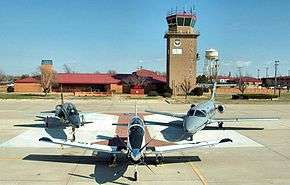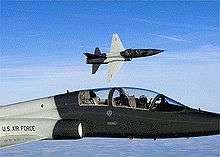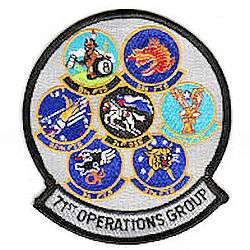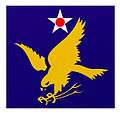71st Operations Group
| 71st Operations Group | |
|---|---|
|
Gaggle patch of 71st Operations Group squadrons | |
| Active | 1941–1946; 1947–1949; 1991–present |
| Country | United States |
| Branch | United States Air Force |




The 71st Operations Group (71 OG) is the operational flying component of the United States Air Force 71st Flying Training Wing. It is stationed at Vance Air Force Base, Oklahoma.
The group's World War II predecessor unit, the 71st Reconnaissance Group operated primarily in the Southwest Pacific Theater flying reconnaissance missions over New Guinea, New Britain, and the Admiralty Islands to provide target and damage-assessment photographs for air force units, It also bombed and strafed Japanese installation and shipping, supported Allied forces on New Guinea and Biak, flew courier missions, participated in rescue operations, and hauled passengers and cargo. The group moved to the Philippines in November 1944 and flew reconnaissance missions over Luzon to provide information for US forces on Japanese troops movements, gun positions, and supply routes. It was awarded the Philippine Presidential Unit Citation for its role in the liberation of the Philippines during 1944–1945. During the postwar years, the unit remained in the Far East and photographed areas of Japan and South Korea, which in 1950, provided much of the initial intelligence of the area when the Korean War broke out.
Major William A. Shomo of the 71st Reconnaissance Group awarded the Medal of Honor for his actions on 11 January 1945 sighting a formation of thirteen Japanese aircraft while leading 3 two-plane flight, Maj. Shomo attacked the superior enemy force and destroyed seven planes.
Overview
The 71 OG conducts joint specialized undergraduate pilot training for over 410 U.S. Air Force, Navy, Marine Corps, and allied student pilots each year. The group utilizes over 200 T-6, T-1, T-38, and A T-38 aircraft, flies more than 55,000 sorties annually, and logs over 81,000 flying hours each year.
- 3d Fighter Training Squadron, T-38 Talon
- 5th Flying Training Squadron, T-1 Jayhawk
- 8th Flying Training Squadron, T-6A Texan II
- 25th Flying Training Squadron, T-38 Talon
- 32d Flying Training Squadron, T-1 Jayhawk
- 33d Flying Training Squadron, T-6A Texan II
- 71st Operations Support Squadron
History
- For additional lineage and history, see 71st Flying Training Wing
The 71st Observation Group trained with B-25, P-38, and P-40 aircraft beginning in October 1941. It moved to California in December 1941 and flew antisubmarine patrols off the west coast, then moved to the Southwest Pacific in the fall of 1943 and flew reconnaissance missions over New Britain, New Guinea, and the Admiralty Islands from bases in New Guinea and Biak. It also flew combat mission against Japanese installations, airfields, and shipping, while supporting Allied ground forces on New Guinea and Biak. During that time, it flew courier missions, participated in rescue operations, and hauled passengers and cargo. From November 1944, the group flew reconnaissance missions over Luzon, supported ground forces, photographed and bombed airfields in Formosa and China, and attacked enemy shipping in the South China Sea.
Maj William A. Shomo earned the Congressional Medal of Honor for shooting down seven enemy aircraft on 11 January 1945. From Ie Shima in August 1945, the 71st attacked transportation targets on Kyushu and flew reconnaissance missions over southern Japan.
From February 1947 to August 1948, the group, equipped with reconnaissance aircraft, flew aerial photographing missions over Japan and southern Korea.
In December 1991, the 71st Operations Group assumed operational control over the 71st Flying Training Wing's T-37, T-38, and later T-1A aircraft, and provided undergraduate pilot training for USAF, Air National Guard, Air Force Reserve, and allied countries. The group provided initial flight training, and follow-on training for fighter, bomber and airlift/tanker aircraft.
Lineage
- Established as 71 Observation Group on 21 August 1941
- Activated on 1 October 1941
- Redesignated: 71 Reconnaissance Group on 2 April 1943
- Redesignated: 71 Tactical Reconnaissance Group on 10 May 1944
- Redesignated: 71 Reconnaissance Group on 20 May 1945
- Inactivated on 1 February 1946
- Activated on 28 February 1947
- Redesignated: 71 Tactical Reconnaissance Group on 18 August 1948
- Inactivated on 1 April 1949
- Redesignated 71 Operations Group on 9 December 1991
- Activated on 15 December 1991.
Assignments
- II Air Support Command, 1 October 1941
- IV Air Support (later, IV Ground Air Support) Command, March 1942
- II Air Support Command (later, II Tactical Air Division), August 1942
- V Bomber Command, November 1943
- 5212 Photographic Reconnaissance Wing (Provisional), 1 March 1944
- Fifth Air Force, 12 April 1944
- 91st Photographic Wing, Reconnaissance, 1 May 1944
- Attached to: 310th Bombardment Wing, 9 January – 29 May 1945
- Attached to: 309th Bombardment Wing, 29 May – 25 September 1945
- Attached to: 310th Bombardment Wing, 25 September – 10 November 1945
- Fifth Air Force, 10 November 1945 – 1 February 1946
- 315th Composite Wing, 28 February 1947
- 314th Composite Wing, 15 April 1947
- 71st Tactical Reconnaissance Wing, 18 August 1948 – 1 April 1949
- 71st Flying Training Wing, 15 December 1991–present
Components
- 7th Flying Training Squadron: 15 December 1991 – 1 October 1992
- 8th Photo Reconnaissance (later, 8 Tactical Reconnaissance; 8 Flying Training) Squadron: 28 February 1947 – 1 April 1949; 15 December 1991–present
- 17th Observation (later, 17 Reconnaissance) Squadron: 26 February 1942 – 1 February 1946
- 25th Observation (later, 25 Liaison) Squadron: 29 March 1942 – 16 February 1945
- 25th Tactical Reconnaissance (later 25 Flying Training) Squadron: 28 February 1947 – 1 April 1949; 15 December 1991–present
- 26th Flying Training Squadron: 15 December 1991 – 1 October 1992
- 31st Reconnaissance Squadron: attached, 27 October 1947 – 1 April 1949
- 32d Flying Training Squadron: 1 June 1995–present
- 33d Flying Training Squadron: 1 October 1998–present
- 82d Observation (later, 82 Reconnaissance; 82 Tactical Reconnaissance) Squadron: 5 April 1942 – 1 February 1946; 28 February 1947 – 1 April 1949
- 102 Observation Squadron: 1 October 1941 – 29 March 1942
- 110 Observation (later, 110 Reconnaissance; 110 Tactical Reconnaissance) Squadron: 1 October 1941 – 20 October 1945
- 128 Observation Squadron: 1 October 1941-c. April 1942
- Flying Training Squadron Provisional, 26: 1 October 1994 – 1 June 1995.
Stations
|
|
Aircraft
|
|
References
![]() This article incorporates public domain material from the Air Force Historical Research Agency website http://www.afhra.af.mil/.
This article incorporates public domain material from the Air Force Historical Research Agency website http://www.afhra.af.mil/.

.svg.png)
